Exhaust Gas Characteristics According to the Injection Conditions in Diesel and DME Engines
Abstract
:1. Introduction
2. Experimental Apparatus and Methodology
2.1. Experimental Setup
2.2. Experimental Methodology
3. Results and Investigations
3.1. Effects of Atomization on Exhaust Gas
3.2. Effects of Injection Pressure on Exhaust Gas Emission Characteristics of Diesel and DME Engines
3.3. Effects of Injection Pressure and Pilot Injection Period on Exhaust Gas Emission Characteristics of DME Engines
3.4. Effects of Pilot Injection Rate on Exhaust Gas According to Injection Time in DME Engines
3.5. Effects of Needle Lift on Exhaust Gas According to Injection Timing in DME Engines
4. Conclusions
- For DME engines, the effect of fuel injection pressure on HC emissions was not significant at low speeds; however, at high speeds, higher fuel injection pressures caused lower HC emissions. To optimize the DME engine, it is necessary to optimize the fuel injection pressure and injection amount depending on the engine operating conditions.
- The emission characteristics of CO were similar to those of HC. The CO emission concentration of DME engines was slightly lower than that of diesel engines. The fuel injection pressure did not have a significant effect at all operating conditions. This was because the combustion characteristics of the oxygenate fuel of DME described in HC. As the liquid fuel DME, which is a compressible oxygen fuel, was injected at high pressure, the mixing ratio with air was improved in the injection characteristic as compared to that with diesel. Further, it was expected to enhance into a diffusive combustion state.
- The HC emission can be extremely low, as it was generated by oxygen deficiency in a state where the combustion chamber wall surface or the air–fuel ratio was rich, and because DME was generated in a state where the fuel was not vaporized and the oxidized fuel was an oxygen fuel. Moreover, as the injection pressure increased, the emission rate of NOx reduced. This was because the injection rate in diesel and DME engines was optimized according to the injection period, and incomplete combustion is not expected.
- The NOx emission was reduced at the injection pressure of 50 MPa, with pilot injection rate increasing from 0% to 30% of the total injected amount, and the minimum and maximum injection timing being 10° and 22° BTDC, respectively. The NOx emission decreased with the increasing pilot injection rate because the pilot injection before the main injection delays the rapid diffusion combustion. This was because the injection period delay lowered the combustion chamber temperature; and it was considered that NOx emissions generated at a high temperature were reduced because the average effective pressure caused by the injection delay decreased.
- It can be seen from this experiment that NOx and HC were opposite to each other. Further, as the pilot injection amount increased, or as it got closer to TDC, the HC emission amount increased. When pilot injection was applied in this study, it was expected that the injection period would be delayed if more than 10% was applied, so that the HC emissions would increase because of unstable combustion.
- The increase in injection timing was caused by the delay in injection period, occurring with the temperature rise in the combustion chamber because of diffusive combustion. The decrease of 0.14 mm and 0.36 mm of needle lift at 22° BTDC was caused by incomplete combustion because of the longer supply period of the characteristics of common rail for supplying the required fuel when injected with the required injection period at 0.14 mm.
Author Contributions
Funding
Conflicts of Interest
References
- Lázaro, L.; Aparecida, C.; Lacava, P. Strategies for emission control in diesel engine to meet Euro VI. Fuel 2013, 104, 183–193. [Google Scholar]
- Miller, B. Fossil Fuel Emissions Control Technologies; Butterworth Heinemann: Oxford, UK, 2015. [Google Scholar]
- Thangaraja, J.; Kannan, C. Effect of exhaust gas recirculation on advanced diesel combustion and alternate fuels: A review. Appl. Energy 2016, 180, 169–184. [Google Scholar] [CrossRef]
- Khair, M. Technical and Synergistic Approaches towards the Twenty-First Century Diesel Engine; SAE Technical Paper 972687; SAE International: Warrendale, PA, USA, 1997. [Google Scholar]
- Digiulio, C.; Pihl, J.; Choi, J.; Parks, J.; Lance, M.; Toops, T.; Amiridis, M.D. NH3 formation over a lean NOX Trap (LNT) system: Effects of lean/rich cycle timing and temperature. Appl. Catal. B 2014, 147, 698–710. [Google Scholar] [CrossRef]
- Elnajjar, E.; Mohammad, O.; Mohamed, S. Experimental investigation of dual engine performance using variable LPG composition fuel. Renew. Energy 2013, 56, 110–116. [Google Scholar] [CrossRef]
- Kalghatgi, G.T.; Hildingsson, L.; Harrison, A.J.; Johansson, B. Auto ignition quality of gasoline fuels in partially premixed combustion in diesel engines. Proc. Combust. Inst. 2011, 33, 3015–3021. [Google Scholar] [CrossRef]
- Kim, H.M.; Kim, Y.J.; Lee, K.H. A study of the characteristics of mixture formation and combustion in a PCCI engine using an early multiple injection strategy. Energy Fuels 2008, 22, 1542–1548. [Google Scholar] [CrossRef]
- Kiplimo, R.; Tomita, E.; Kawahara, N.; Yokobe, S. Effects of spray impingement, injection parameters, and EGR on the combustion and emission characteristics of a PCCI diesel engine. Appl. Therm. Eng. 2012, 37, 165–175. [Google Scholar] [CrossRef]
- Abdelaal, M.M.; Hegab, A.H. Combustion and emission characteristics of a natural gas-fueled diesel engine with EGR. Energy Convers. Manag. 2012, 64, 301–312. [Google Scholar] [CrossRef]
- Kumaraswamy, A.; Durga Prasad, B. Performance analysis of a dual fuel engine using LPG and diesel with EGR system. Proc. Eng. 2012, 38, 2784–2792. [Google Scholar] [CrossRef]
- Hosseinzadeh, A.; Saray, R.K.; Mahmoudi, S.S. Comparison of thermal, radical and chemical effects of EGR gases using availability analysis in dual-fuel engines at part loads. Energy Convers. Manag. 2010, 51, 2321–2329. [Google Scholar] [CrossRef]
- Lee, K.; Lee, C. An Experimental Study of the Extent of the Operating Region and Emission Characteristics of Stratified Combustion Using the Controlled Autoignition Method. Energy Fuels 2006, 20, 1862–1869. [Google Scholar] [CrossRef]
- Lee, C.; Tomita, E.; Lee, K. Characteristics of Combustion Stability and Emission in SCCI and CAI Combustion Based on Direct-Injection Gasoline Engine; SAE Technical Paper 2007-01-1872; SAE International: Warrendale, PA, USA, 2007. [Google Scholar]
- Lee, C.H.; Lee, K.H. An Experimental Study on the Combustion and Emission Characteristics of a Stratified Charge Compression Ignition (SCCI) Engine. Energy Fuels 2007, 21, 1901–1907. [Google Scholar] [CrossRef]
- Lee, C.-H.; Lee, K.-H.; Lim, K.-B. An Experimental Study on the Combustion and Emission Characteristics According to the Variation of Compression Ratio and Intake Temperature Using Stratified Charge Compression Ignition in a Gasoline Direct Injection Engine. Trans. Korean Soc. Mech. Eng. B 2006, 30, 538–545. [Google Scholar] [CrossRef]
- Lee, S.; Oh, S.; Choi, Y. Performance and emission characteristics of an SI engine operated with DME blended LPG fuel. Fuel 2009, 88, 1009–1015. [Google Scholar] [CrossRef]
- Park, S. Optimization of combustion chamber geometry and engine conditioned for compression ignition engines fueled with dimethyl ether. Fuel 2012, 97, 61–71. [Google Scholar] [CrossRef]
- Yeom, K.; Bae, C. Knock characteristics in liquefied petroleum gas (LPG) = dimethyl ether (DME) and gasoline–DME homogeneous charge compression ignition engines. Energy Fuels 2009, 23, 1956–1964. [Google Scholar] [CrossRef]
- Park, S. Numerical study on optimal operating conditions of homogeneous charge compression ignition engines. Energy Fuels 2009, 23, 2909–2918. [Google Scholar]
- Zhou, L.B.; Wang, H.W.; Jiang, D.M.; Huang, Z. Study of Performance and Combustion Characteristics of a DME Fuelled Light-Duty Direct Injection Diesel Engine; SAE Paper 1999; SAE International: Warrendale, PA, USA, 1999. [Google Scholar]
- Fleisch, T.; McCarthy, C.; Basu, A. A new clean diesel technology: Demonstration of ULEV emissions on a Navistar diesel engine fuelled with dimethyl ether. J. Fuels Lubr. 1995, 104, 42–53. [Google Scholar]
- Clausen, L.R.; Elmegaard, B.; Houbak, N. Design of Novel DME/Methanol Synthesis Plants Based on Gasification of Biomass; DCAMM Special Report, No. S123; Technical University of Denmark (DTU): Lyngby, Denmark, 2011. [Google Scholar]
- Ying, W.; Li, H.; Jie, Z.; Longbao, Z. Study of HCCI–DI combustion and emissions in a DME engine. Fuel 2009, 88, 2255–2261. [Google Scholar] [CrossRef]
- Xinling, L.; Zhen, H. Emission reduction potential of using gas-to-liquid and dimethyl ether fuels on a turbocharged diesel engine. Sci. Total Environ. 2009, 407, 2234–2244. [Google Scholar] [CrossRef]
- Junjun, Z.; Xinqi, Q.; Zhen, W.; Bin, G.; Zhen, H. Experimental investigation of low-temperature combustion (LTC) in an engine fuelled with dimethyl ether (DME). Energy Fuels 2009, 23, 170–174. [Google Scholar] [CrossRef]
- Jang, J.; Bae, C. Effects of valve events on the engine efficiency in a homogeneous charge compression ignition engine fuelled by dimethyl ether. Fuel 2009, 88, 1228–1234. [Google Scholar] [CrossRef]
- AVL. AVL Global Emission Legislation Report 2011. Available online: https://www.avl.com/web/guest/avl-focus-2011 (accessed on 13 February 2019).
- Park, S.H.; Lee, C.S. Combustion performance and emission reduction characteristics of automotive DME engine system. Prog. Energy Combust. Sci. 2013, 39, 147–168. [Google Scholar] [CrossRef]
- Fonseca de Carvalho e Silva, D. DME as Alternative Diesel Fuel: Overview; SAE Paper 2006-01-2916; SAE International: Warrendale, PA, USA, 2006. [Google Scholar]
- Song, J.; Huang, Z.; Qiao, X.Q.; Wang, W.L. Performance of a controllable premixed combustion engine fueled with dimethyl ether. Energy Convers. Manag. 2004, 45, 2223–2232. [Google Scholar] [CrossRef]
- Fischer, S.L.; Dryer, F.L.; Curran, H.J. The Reaction Kinetics of Dimethyl Ether. I: High-Temperature Prolysis and Oxidation in Flow Reactors. Int. J. Chem. Kinet. 2000, 32, 713–740. [Google Scholar] [CrossRef]
- Curran, H.J.; Fischer, S.L.; Dryer, F.L. The Reaction Kinetics of Dimethyl Ether. II: Low-Temperature Oxidation in Flow Reactors. Int. J. Chem. Kinet. 2000, 32, 741–789. [Google Scholar] [CrossRef]
- Teng, H.; McCandless, J.C.; Schneyer, B. Thermodynamic Properties of Dimethyl Ether—An Alternative Fuel for Compression-Ignition Engines; SAE Paper 2004-01-0093; SAE International: Warrendale, PA, USA, 2004. [Google Scholar]
- How, H.G.; Masjuki, H.H.; Kalam, M.A.; Teoh, Y.H. Influence of injection timing and split injection strategies on performance, emissions, and combustion characteristics of diesel engine fueled with biodiesel blended fuels. Fuel 2018, 213, 106–114. [Google Scholar] [CrossRef]
- Jain, A.; Singh, A.P.; Agarwal, A.K. Effect of split fuel injection and EGR on NOx and PM emission reduction in a low temperature combustion (LTC) mode diesel engine. Energy 2017, 122, 249–264. [Google Scholar] [CrossRef]
- Guardiola, C.; Martín, J.; Pla, B.; Bares, P. Cycle by cycle NOx model for diesel engine control. Appl. Therm. Eng. 2017, 110, 1011–1020. [Google Scholar] [CrossRef]
- Corsini, A.; Fanfarillo, G.; Rispoli, F.; Venturini, P. Pollutant Emissions in Common-rail Diesel Engines in Extraurban Cycle: Rapeseed Oils vs Diesel Fuel. Energy Procedia 2015, 82, 141–148. [Google Scholar] [CrossRef] [Green Version]
- Lee, C.; Chung, J.; Lee, K. Emission Characteristics for a Homogeneous Charged Compression Ignition Diesel Engine with Exhaust Gas Recirculation Using Split Injection Methodology. Energies 2017, 10, 2146. [Google Scholar] [CrossRef]
- Watanabe, H.; Tahara, T.; Tamanouchi, M.; Iida, J. Study of the effects on exhaust emissions in direct injection diesel engines: Effects of fuel injection system, distillation properties and cetane number. JSAE Rev. 1998, 19, 21–26. [Google Scholar] [CrossRef]
- Cédric, L.; Goriaux, M.; Tassel, P.; Perret, P.; Liu, Y. Impact of Aftertreatment Device and Driving Conditions on Black Carbon, Ultrafine Particle and NOx Emissions for Euro 5 Diesel and Gasoline Vehicles. Transp. Res. Procedia 2016, 14, 3079–3088. [Google Scholar] [CrossRef] [Green Version]
- Twigg, M.V. Advanced integrated exhaust aftertreatment systems and the mechanisms of NOx emissions control. In Proceedings of the Internal Combustion Engines: Performance, Fuel Economy and Emissions IMechE, London, UK, 27–28 November 2013; pp. 219–229. [Google Scholar]
- Cordiner, S.; Mulone, V.; Nobile, M.; Rocco, V. Impact of biodiesel fuel on engine emissions and Aftertreatment System operation. Appl. Energy 2016, 164, 972–983. [Google Scholar] [CrossRef]
- Lee, C. Numerical and experimental investigation of evaporation and mixture uniformity of urea–water solution in selective catalytic reduction system. Transp. Res. Part D Transp. Environ. 2018, 60, 210–224. [Google Scholar] [CrossRef]
- Lee, C. Modeling urea-selective catalyst reduction with vanadium catalyst based on NH3 temperature programming desorption experiment. Fuel 2016, 173, 155–163. [Google Scholar] [CrossRef]
- Winkel, A.; Mosquera, J.; Aarnink, A.J.A.; Koerkamp, P.W.G.G.; Ogink, N.W.M. Evaluation of oil spraying systems and air ionisation systems for abatement of particulate matter emission in commercial poultry houses. Biosyst. Eng. 2016, 150, 104–122. [Google Scholar] [CrossRef]
- Hamid, M.F.; Idroas, M.Y.; Sa’add, S.; Bahri, A.J.S.; Zainal, Z.A. Numerical investigation of in-cylinder air flow characteristic improvement for Emulsified biofuel (EB) application. Renew. Energy 2018, 127, 84–93. [Google Scholar] [CrossRef]
- Yoon, S.H.; Kim, H.J.; Park, S. Study on optimal combustion strategy to improve combustion performance in a single-cylinder PCCI diesel engine with different combustion chamber geometry. Appl. Therm. Eng. 2018, 144, 1081–1090. [Google Scholar] [CrossRef]
- Li, X.-R.; Yang, W.; Su, L.-W.; Liu, F.-S. Mixing and combustion mechanisms within lateral swirl combustion system (LSCS) in a DI diesel engine. Appl. Therm. Eng. 2017, 123, 7–18. [Google Scholar] [CrossRef]
- Lee, C.H.; Lee, K.H. An experimental study of the combustion characteristics in SCCI and CAI based ondirect-injection gasoline engine. Exp. Therm. Fluid Sci. 2007, 31, 1121–1132. [Google Scholar] [CrossRef]
- Lee, C.; Lee, K. An experimental study on the flow and mixture distribution in a visualization engine using digital particle image velocimetry and entropy analysis. Int. J. Automot. Technol. 2007, 8, 127–135. [Google Scholar]
- Reitz, R.D.; Duraisamy, G. Review of high efficiency and clean reactivity controlled compression ignition (RCCI) combustion in internal combustion engines. Prog. Energy Combust. Sci. 2015, 46, 12–71. [Google Scholar] [CrossRef] [Green Version]
- Tan, P.; Li, Y.; Shen, H. Effect of lubricant sulfur on the morphology and elemental composition of diesel exhaust particles. J. Environ. Sci. 2017, 55, 354–362. [Google Scholar] [CrossRef] [PubMed]
- Hori, S.; Sato, T.; Narusawa, K. Effects of diesel fuel composition on SOF and PAH exhaust emissions. JSAE Rev. 1997, 18, 255–261. [Google Scholar] [CrossRef]
- Zhu, L.; Zhang, W.; Liu, W.; Huang, Z. Experimental study on particulate and NOx emissions of a diesel engine fueled with ultra-low sulfur diesel, RME-diesel blends and PME-diesel blends. Sci. Total Environ. 2010, 408, 1050–1058. [Google Scholar] [CrossRef] [PubMed]
- Gelso, E.R.; Dahl, J. Diesel Engine Control with Exhaust Aftertreatment Constraints. IFAC-PapersOnLine 2017, 50, 8921–8926. [Google Scholar] [CrossRef]
- Reijnders, J.; Boot, M.; de Goey, P. Particle nucleation-accumulation mode trade-off: A second diesel dilemma? J. Aerosol Sci. 2018, 124, 95–111. [Google Scholar] [CrossRef]
- Alam, M.; Fujita, O.; Ito, K.; Kajitani, S.; Oguma, M.; Machida, H. Comparison of NOx Reduction Performance with NOx Catalyst in Simulated Gas and Actual DME Engine Exhaust Gas. J. Power Energy 2004, 218, 89–95. [Google Scholar] [CrossRef]
- Cipolat, D. DME as a Fuel for Compression Ignition Engines; SAE Technical Paper 2001-24-0039; SAE International: Warrendale, PA, USA, 2001. [Google Scholar]
- Mizusawa, K.; Katoh, K.; Hamaguchi, S.; Hayashi, H.; Hocho, S. Development of Air Fuel Ratio Sensor for 1997 Model Year LEV Vehicle; SAE Technical Paper 970843; SAE International: Warrendale, PA, USA, 1997. [Google Scholar]
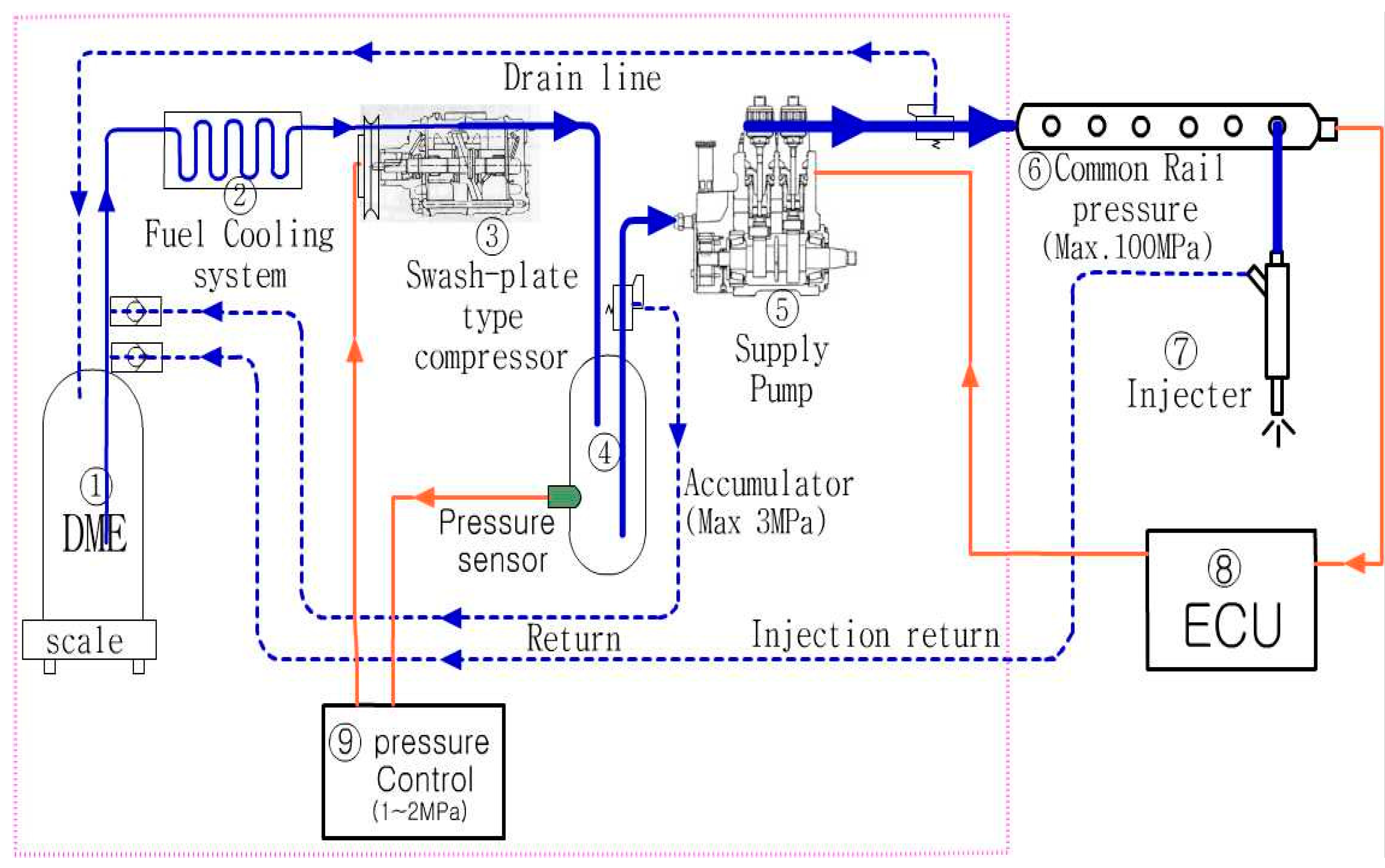
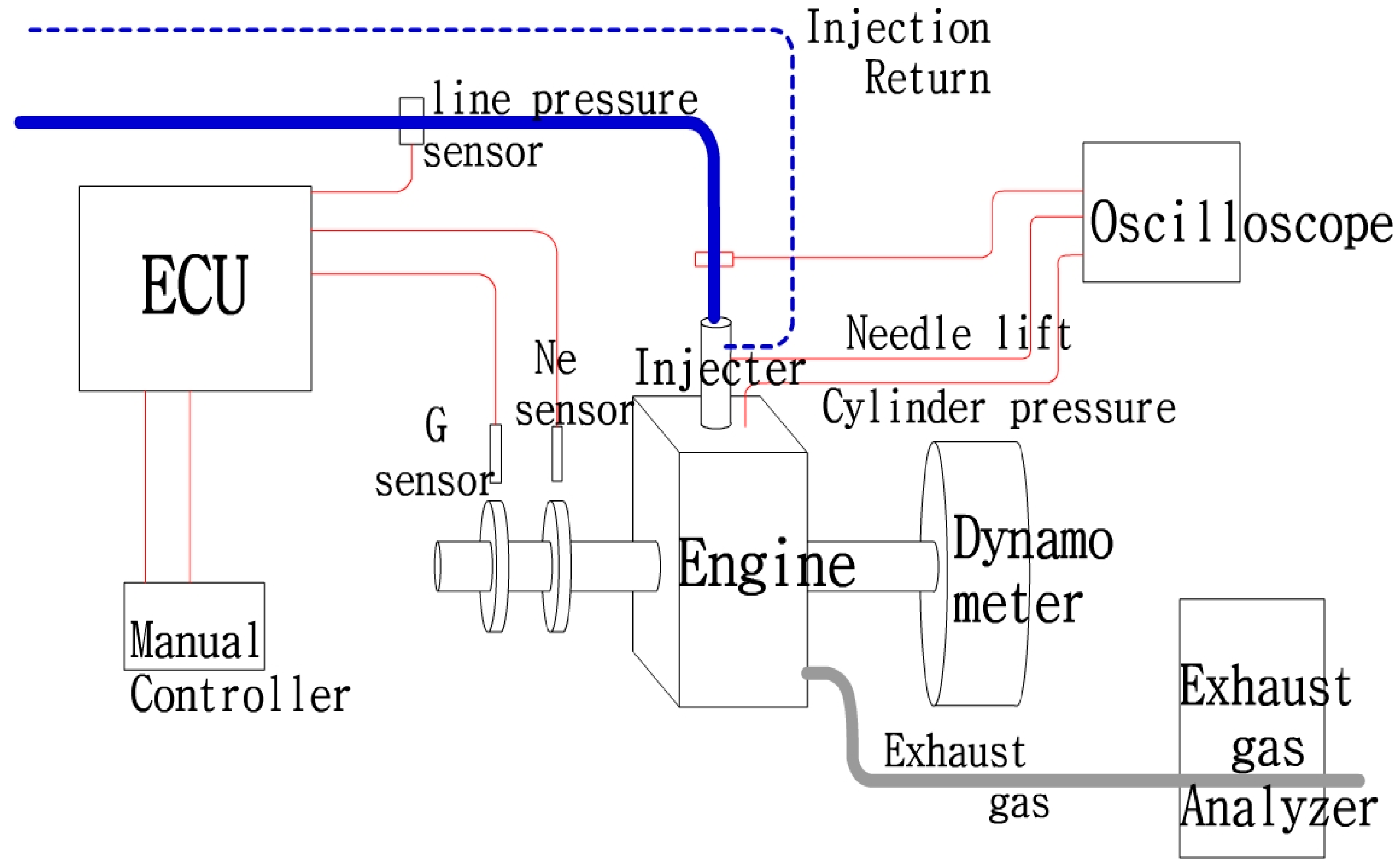
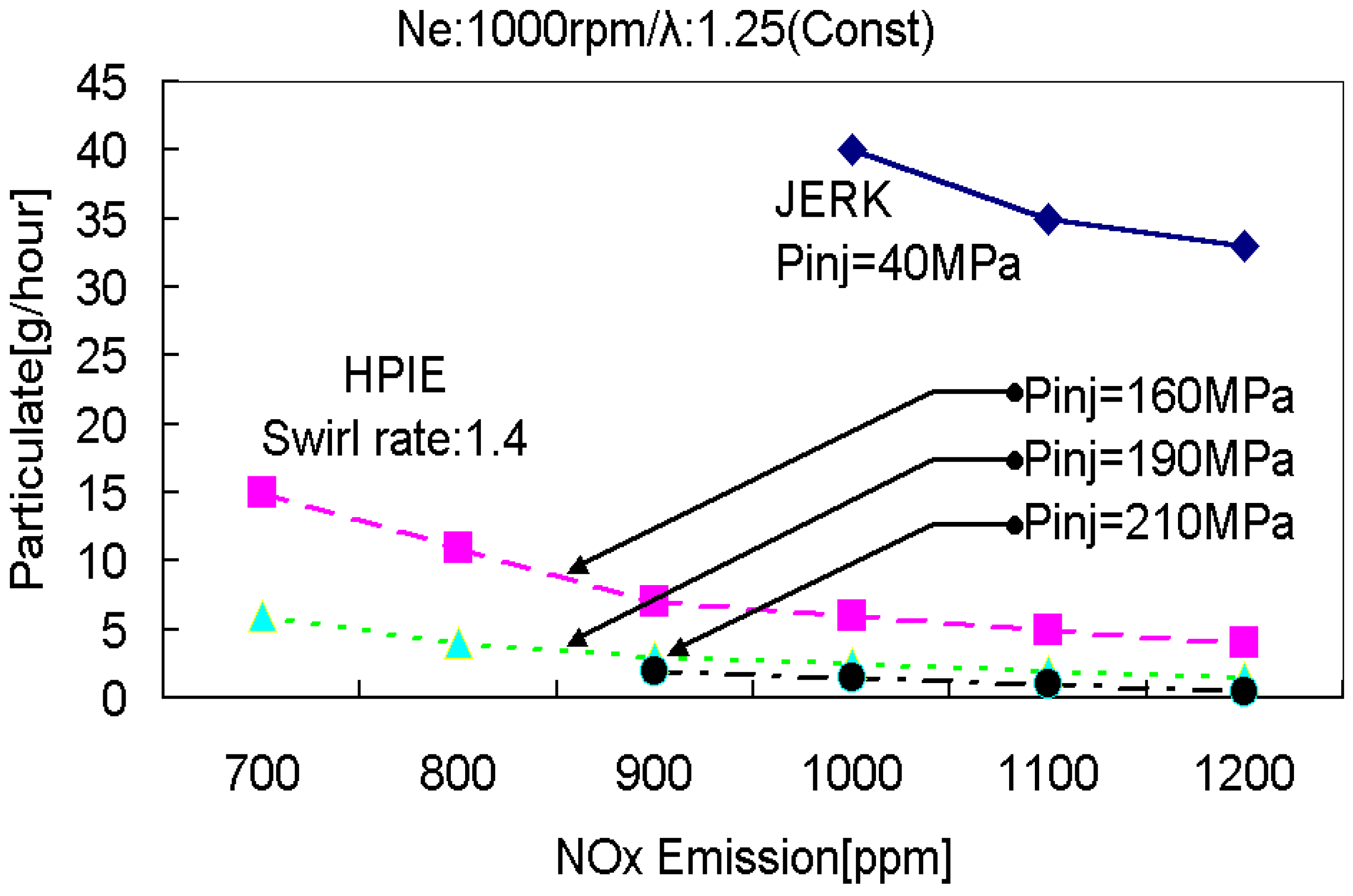
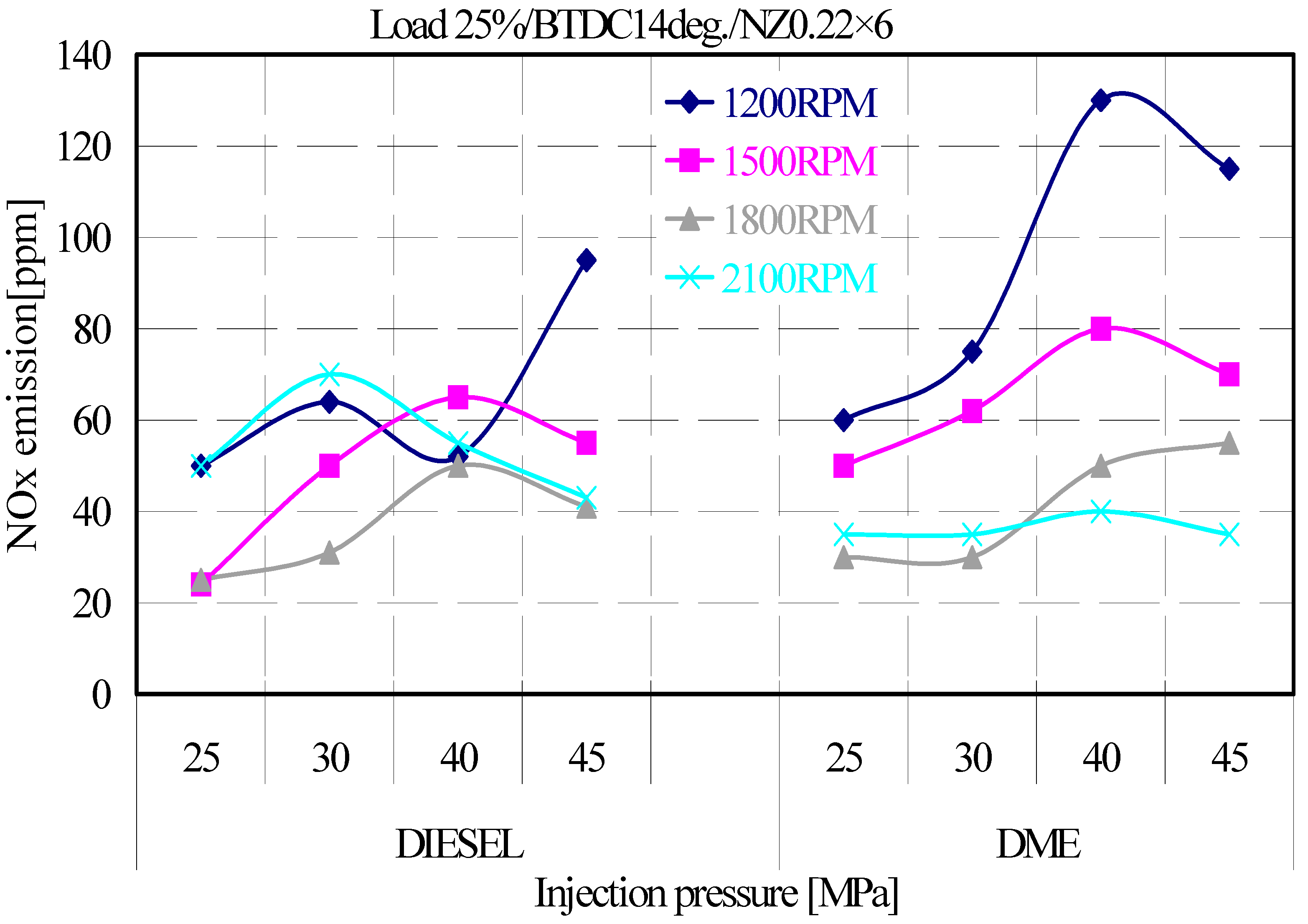
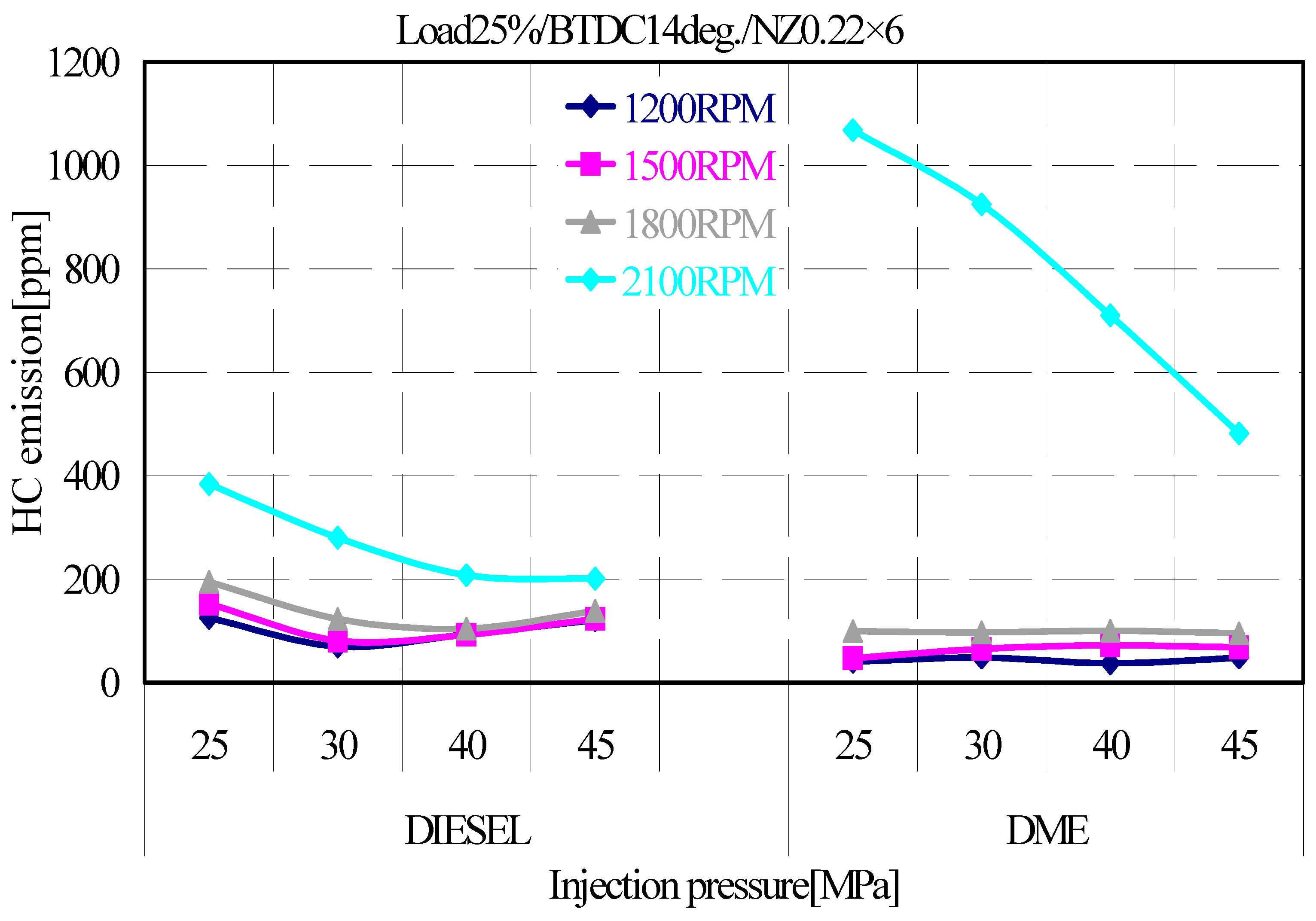
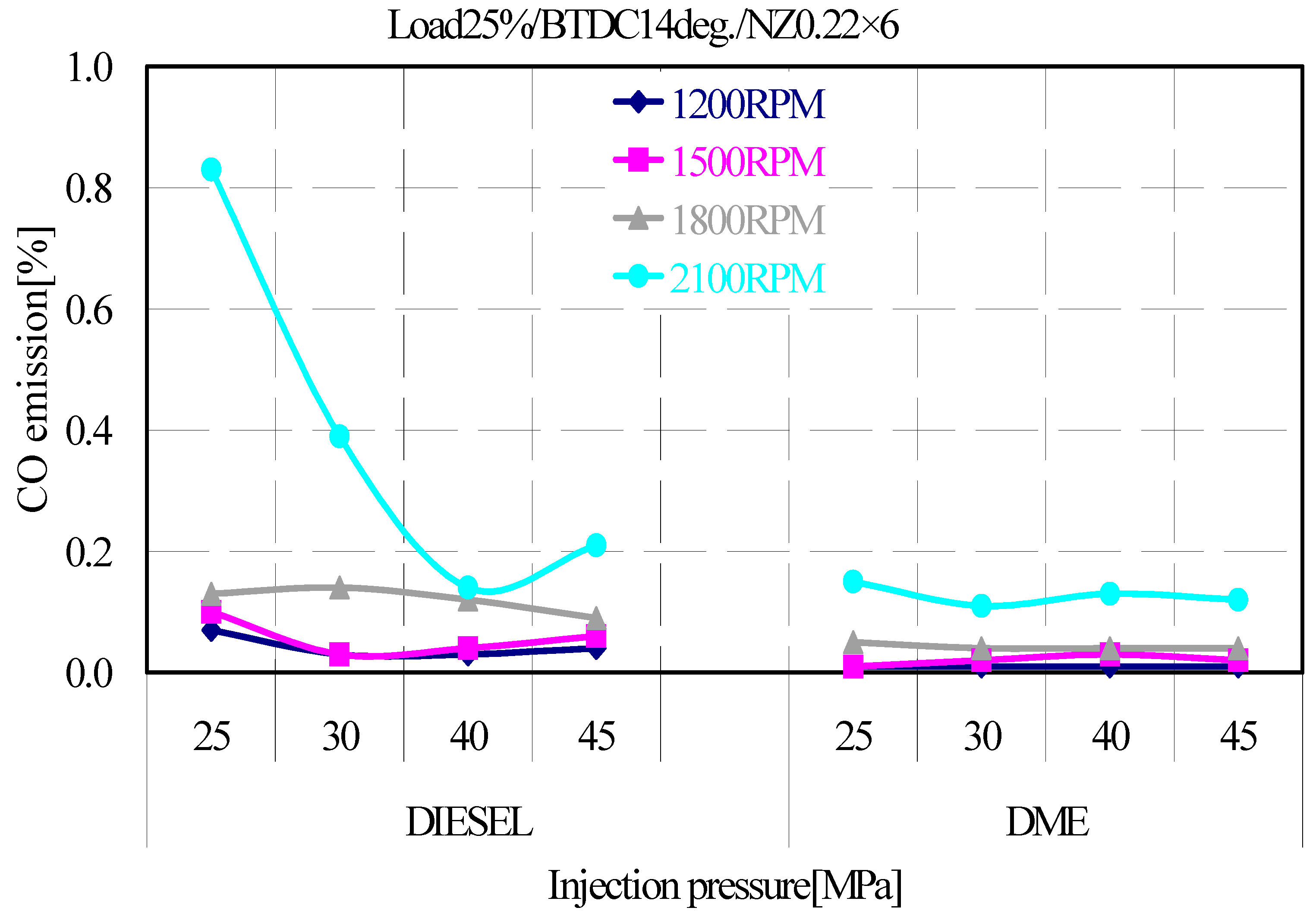
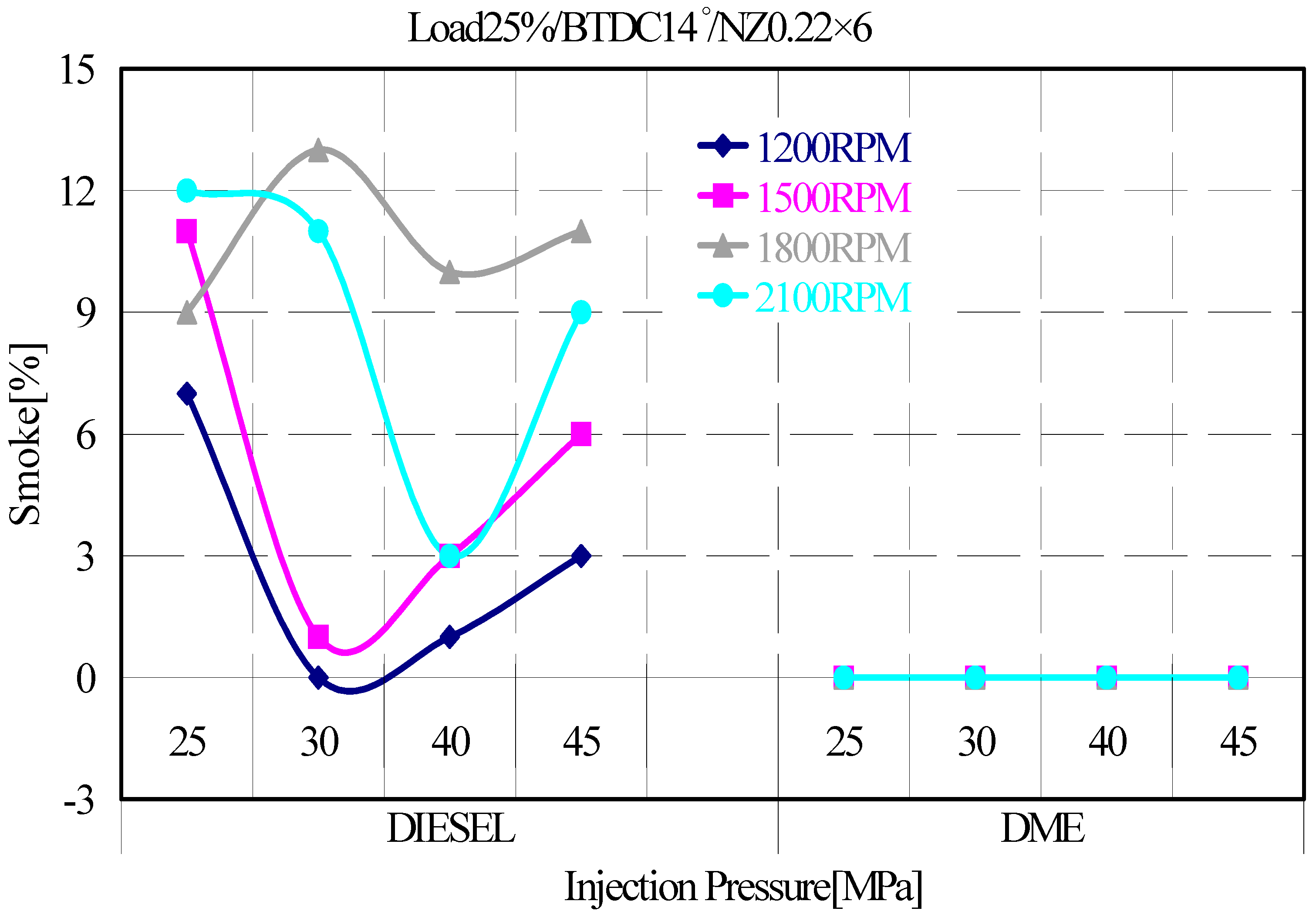
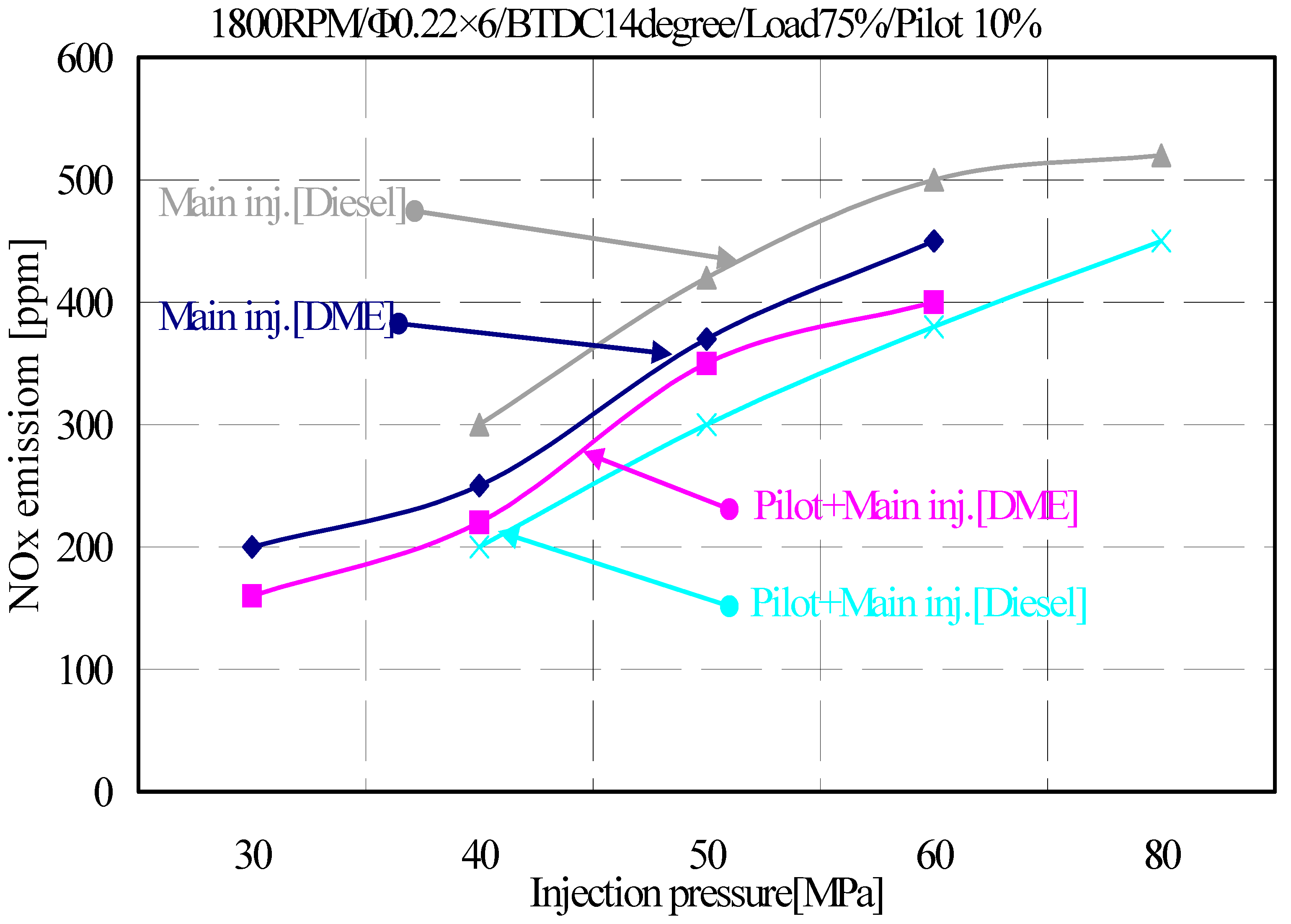

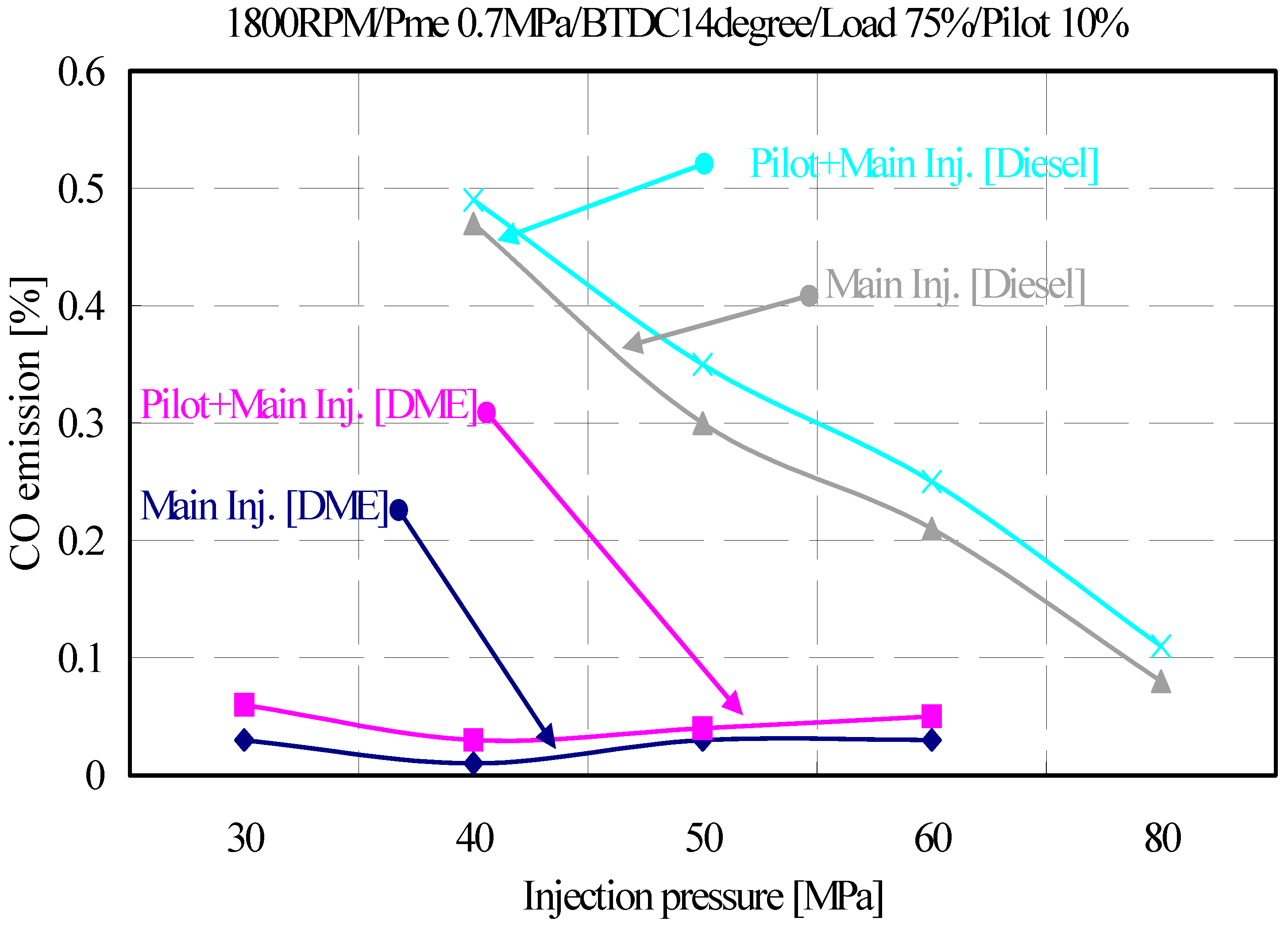
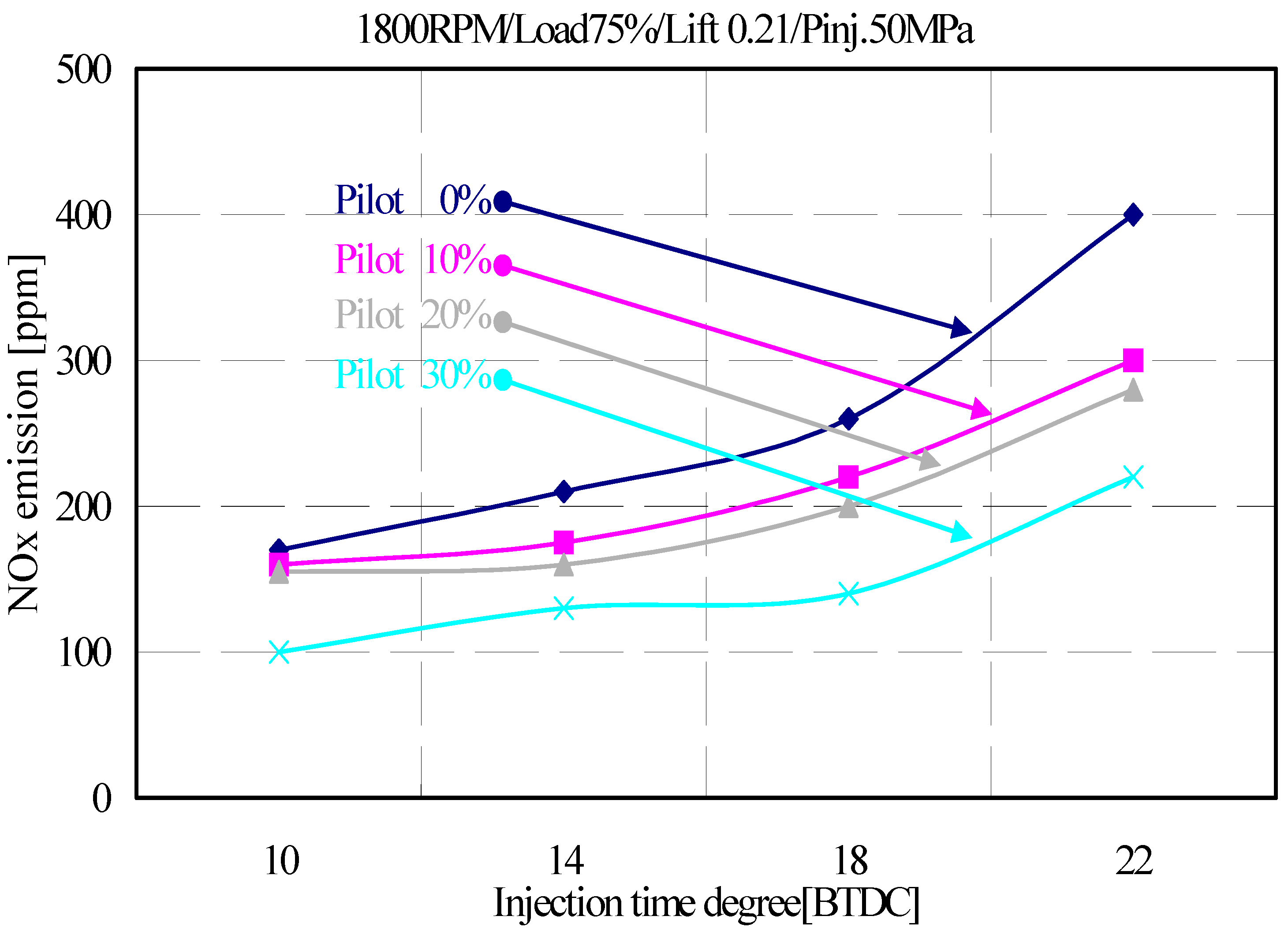
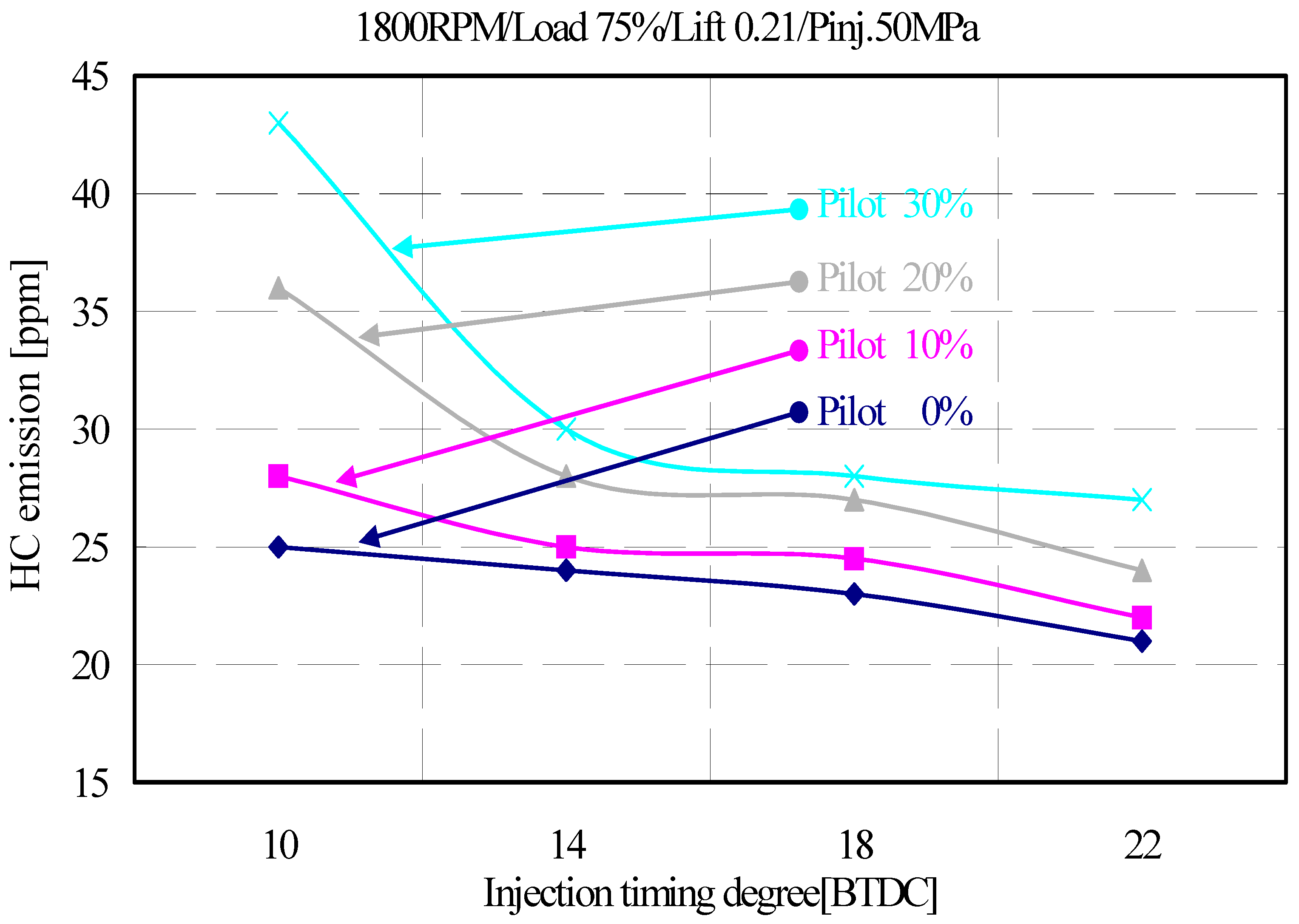


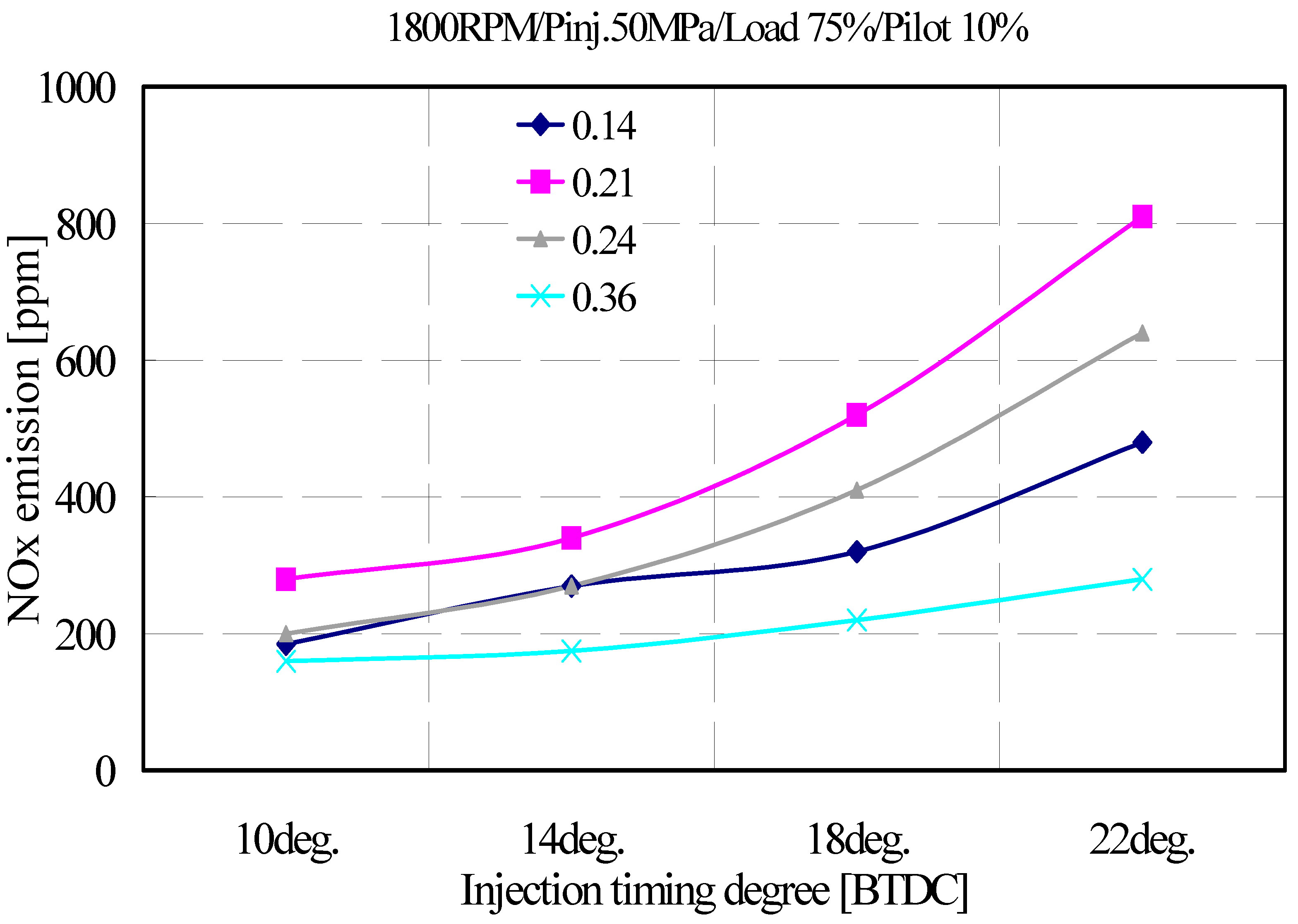

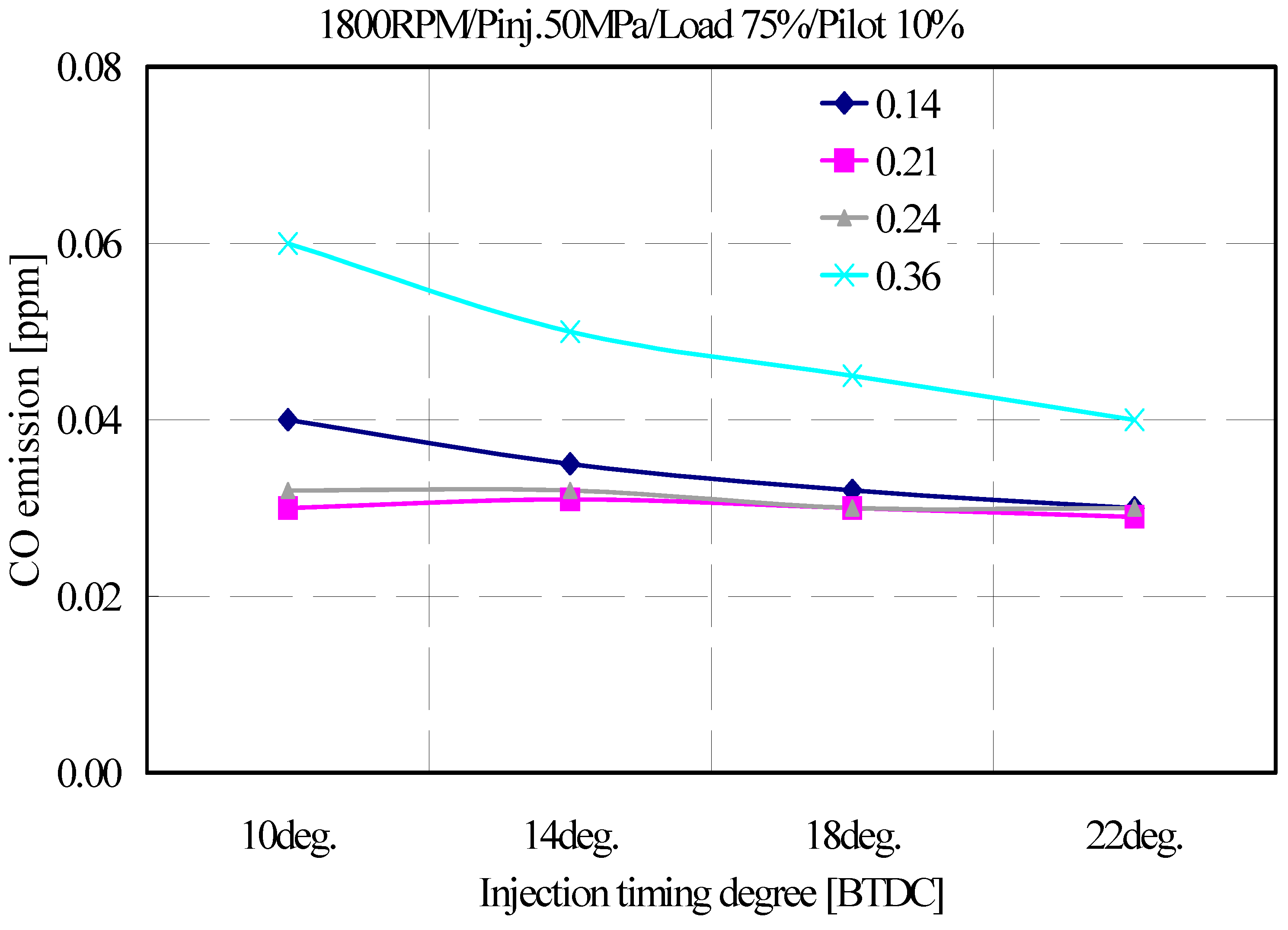
| Items | Specifications |
|---|---|
| Cycle | 4 |
| Combustion Type | CI |
| Compression Ratio | 18 |
| Displacement (ℓ) | 0.673 |
| Bore × Stroke (mm × mm) | 95 × 95 |
| Max. Power (kW/rpm) | 9.11/2200 |
| Max. Torque (kg m) | 4.22 |
| Emission | Methods | Effects of Reduction |
|---|---|---|
| NOx | Injection timing delay | Lowering of combustion temperature [35] |
| Exhaust gas recirculation | Lowering of combustion temperature [36] | |
| Lowering of oxygen thickness [37] | ||
| Water fulmination | Lowering of combustion temperature [38] | |
| Fuel–water injection | ||
| Pilot injection | Lowering of combustion rate in the first period [39] | |
| Improving cetane number | Lowering of combustion rate in the first period [40] | |
| After treatment | NOx recharge and resolve [41,42,43,44,45] | |
| PM | Spray improvement | Air inhalation increase in spray [46] |
| Mixing increase [47] | ||
| Optimization in combustion chamber | Mixing increase [48] | |
| Increase in air usage rate [49] | ||
| Confusion combustion | Mixing increase [50] | |
| Increase of smoke oxidation [51] | ||
| Turbo charging | Lean burn combustion [52] | |
| Air inhalation increase in spray [52] | ||
| Reduction in oil consumption | Reduction of SOF [53] | |
| Low sulfur fuel | Reduction of sulfur combination matter [53,54,55] | |
| After treatment | Smoke catching and SOF oxidation [56,57] |
© 2019 by the authors. Licensee MDPI, Basel, Switzerland. This article is an open access article distributed under the terms and conditions of the Creative Commons Attribution (CC BY) license (http://creativecommons.org/licenses/by/4.0/).
Share and Cite
Yang, S.; Lee, C. Exhaust Gas Characteristics According to the Injection Conditions in Diesel and DME Engines. Appl. Sci. 2019, 9, 647. https://doi.org/10.3390/app9040647
Yang S, Lee C. Exhaust Gas Characteristics According to the Injection Conditions in Diesel and DME Engines. Applied Sciences. 2019; 9(4):647. https://doi.org/10.3390/app9040647
Chicago/Turabian StyleYang, Seamoon, and Changhee Lee. 2019. "Exhaust Gas Characteristics According to the Injection Conditions in Diesel and DME Engines" Applied Sciences 9, no. 4: 647. https://doi.org/10.3390/app9040647





